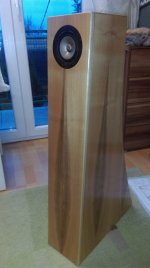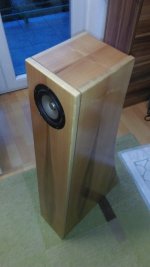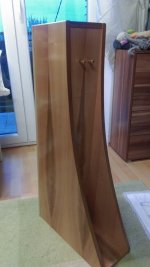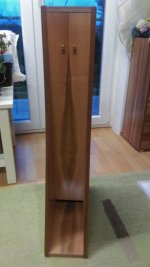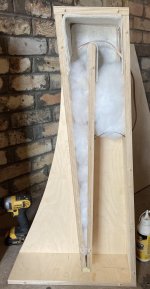i would second that , i really think that my 300B ( 8 W ... ) would destroy the FE126 at max level within a few minutes only ....It is usually better to have too much power than too little but 10w is probably sufficient for FE126.
dave
Plywood is definitly better (you do want quality plywood, many plies). MDF is only a lat choice if there is absolutely nothing else. Despite its populariity MDF is not (IMO and many others) suitable for bulding loudspeakers. Its big advantage is that it is cheap, cheap to work, cheap to finish. It is cheap.
The $40 cheaper is very false value. We had access to (almost) as much free MDF as we wanted, but we spent $90 a sheet for Murphy Ply.
dave
The $40 cheaper is very false value. We had access to (almost) as much free MDF as we wanted, but we spent $90 a sheet for Murphy Ply.
dave
Despite its populariity MDF is not (IMO and many others) suitable for bulding loudspeakers.
Please elaborate, what exactly would make MDF unsuitable or plywood superior? Also plywood is general covering many types, layer counts, glue types, wood types and which would not all have equivalent density or resonance, would you recommend all types over MDF? Doesn’t a simple knock test show MDF to be ‘deader’ then most plywood?
Quality plywood, not 5 ply from home depot. The 18mm we used has 15 plies, the 15mm 13.
MDF is not as stiff as plywood and not really as well damped (each ply transition acts as a damping mechanism). It is also lighter. That means that it is much easier to push resonances up (in frequency & Q) where they are much less likely to get excited and i fthey start to happen are better damped. The FHs, Pensils, Woden’s boxes, mine are all designed with plywood in mind.
dave
MDF is not as stiff as plywood and not really as well damped (each ply transition acts as a damping mechanism). It is also lighter. That means that it is much easier to push resonances up (in frequency & Q) where they are much less likely to get excited and i fthey start to happen are better damped. The FHs, Pensils, Woden’s boxes, mine are all designed with plywood in mind.
dave
Dave and Scott,
This has been in the back of my mind for a long time, so I am just going to say it.
To me, the Frugel-Horns don't look like horns at all. They look more like a Big Vent Mass Loaded Folded Voight Pipe. If so, I guess "Frugel-Horn" rolls off the tongue better than BVMLFVP. 🙂
Just being silly. But really. Aren't they a BVMLFVP?
This has been in the back of my mind for a long time, so I am just going to say it.
To me, the Frugel-Horns don't look like horns at all. They look more like a Big Vent Mass Loaded Folded Voight Pipe. If so, I guess "Frugel-Horn" rolls off the tongue better than BVMLFVP. 🙂
Just being silly. But really. Aren't they a BVMLFVP?

Last edited:
Even when not sufficiently braced I think plywood offers greater potential. However assuming you wanted greater control over the issue, you could damp the panels yourself. For some extra work the result between the types will converge.Please elaborate, what exactly would make MDF unsuitable or plywood superior?
Dave and Scott,
This has been in the back of my mind for a long time, so I am just going to say it.
To me, the Frugel-Horns don't look like horns at all.
Been asked a few times earlier on this thread. 😉 As Dave says, they're a [single] tapped horn, aka Voigt horn variant. There is no vent, but they have an internal low-pass choke to help filter off the unwanted midrange. The location is a matter of convenience for size, folding and minimising the number of panels. This is one reason we said from the outset that all the physical dimensions are functional and serve several purposes, although they might not always be visually obvious ones. It's also why the FH3 load per se doesn't necessarily scale well due to sizing constraints; the others in the family introduce variations, although again, these are buried in the physics rather than necessarily showing major departures in appearance.
Performing initial tests. One side is glued on, lining and stuffing are in the cabinets.
First impressions: fantastic! Worth the effort. Spotify sounds like garbage.. Records and lossless files however are crisp, detailed. Sound is nicely balanced and as is usually reported, bass is much more present than you might expect. I've never listened to FR drivers before... the word that comes to mind is smooth.
I have my sub set to very low volume and it's almost not necessary.
Thanks to @Roo2 for the suggestions on stuffing and helping me decide on the 7MS.
Final glue up will be this week and I'll continue to break the speakers in while I wait for finishing materials.
Amp is a Yamaha A-S301 and Turntable is a Pro-Ject Debut Carbon.

First impressions: fantastic! Worth the effort. Spotify sounds like garbage.. Records and lossless files however are crisp, detailed. Sound is nicely balanced and as is usually reported, bass is much more present than you might expect. I've never listened to FR drivers before... the word that comes to mind is smooth.
I have my sub set to very low volume and it's almost not necessary.
Thanks to @Roo2 for the suggestions on stuffing and helping me decide on the 7MS.
Final glue up will be this week and I'll continue to break the speakers in while I wait for finishing materials.
Amp is a Yamaha A-S301 and Turntable is a Pro-Ject Debut Carbon.

Last edited:
First impressions: fantastic! Worth the effort.
I agree they are and yours are a lovely build. They will only get better. Some things are more than just the sum of their parts and the FH's are proof of that.
Cheers - J
alsyd , Cindra,
Congratulations on your successful builds - enjoy!
Cindra,
How are you finding the Pluvia 7HD?
Congratulations on your successful builds - enjoy!
Cindra,
How are you finding the Pluvia 7HD?
Its early, just hook them up today. They seems more smooth right from the box than CHP-70gen2 i was using. I will see after week or so where will they go 😀
Cindra, lovely work on the grain pattern matching - always a priority for me with highly figured species.
Thanks all!
Attached is my current set up with stuffing at the moment, ~30g under the driver and ~30g in the point. Understand that not everyone has experience with the 7MS driver specifically, but - the signature in acoustic and more relaxed/indie rock music is pretty much perfect, but introducing electronic or heavier rock is bass-heavy and the mids are drowned out.
Any suggestions for adding stuffing? I've started fairly light and am going to do some experimenting today, but general guidance would be great. Do people generally put stuffing behind or immediately behind the driver? Would more under the driver or in the point help for controlling low-end?
Thanks again!
Attached is my current set up with stuffing at the moment, ~30g under the driver and ~30g in the point. Understand that not everyone has experience with the 7MS driver specifically, but - the signature in acoustic and more relaxed/indie rock music is pretty much perfect, but introducing electronic or heavier rock is bass-heavy and the mids are drowned out.
Any suggestions for adding stuffing? I've started fairly light and am going to do some experimenting today, but general guidance would be great. Do people generally put stuffing behind or immediately behind the driver? Would more under the driver or in the point help for controlling low-end?
Thanks again!
Attachments
- Home
- Loudspeakers
- Full Range
- Frugel-Horn Mk3 Builds & Build Questions
